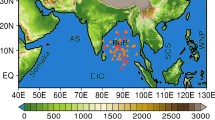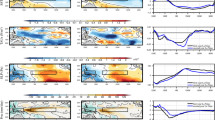Abstract
It is shown here that the teleconnections of El Niño-Southern Oscillation (ENSO) are contributed by two anomalous precipitation forcings in the equatorial central Pacific (CP; 160°E–120°W, 5°S–5°N) and western North Pacific (WNP; 110°E–150°E, 0°N–20°N). The positive CP precipitation anomalies induce a prevailing cyclonic flow over the North Pacific (120°E–110°W, 20°N–70°N), whereas the negative WNP precipitation forcing tends to induce anticyclonic anomalies over the Kuroshio extension region and North Pacific. It is demonstrated that the equatorial CP and WNP precipitation anomalies play relative roles in generating atmospheric teleconnections over the North Pacific, which can be determined by the competing responses to the CP and WNP precipitation anomalies. The reconstructed teleconnection patterns based on only the two tropical forcings capture the majority of the subseasonal evolution of the ENSO teleconnection. In addition, we find that the diversity of inter-ENSO events in the atmospheric teleconnection can be better-explained by considering the relative roles of the CP and WNP precipitation anomalies.







Similar content being viewed by others
References
Bjerknes J (1969) Atmospheric teleconnections from the equatorial Pacific. Mon Weather Rev 97:163–172
Bladé I, Newman M, Alexander MA, Scott JD (2008) The late fall extratropical response to ENSO: sensitivity to coupling and convection in the tropical West Pacific. J Clim 21:6101–6118
Gill AE (1980) Some simple solutions for heat-induced tropical circulations. Q J R Meteorol Soc 106:447–462
Goss M, Feldstein SB (2017) Why do similar patterns of tropical convection yield extratropical circulation anomalies of opposite sign? J Atmos Sci 74:487–511
Horel JD, Wallace JM (1981) Planetary scale atmospheric phenomena associated with the Southern Oscillation. Mon Weather Rev 125:773–788
Hoskins BJ, Karoly DJ (1981) The steady linear response of a spherical atmosphere to thermal and orographic forcing. J Atmos Sci 38:1179–1196
Huffman GJ, Adler RF, Bolvin DT, Gu G (2009) Improving the global precipitation record: GPCP Version 2.1. Geophys Res Lett 36:L17808
Kalnay E et al (1996) The NCEP/NCAR 40-year reanalysis project. Bull Am Meteorol Soc 77:437–471
Kim S, Kim H-S, Min S-K, Son H-Y, Won D-J, Jung H-S, Kug J-S (2015) Intra-winter atmospheric circulation changes over East Asia and North Pacific associated with ENSO in a seasonal prediction model. Asia Pac J Atmos Sci 51:49–60
Kim S, Son H-Y, Kug J-S (2017) How well do climate models simulate atmospheric teleconnections over the North Pacific and East Asia associated with ENSO? Clim Dyn 48:971–985
Lau N-C, Nath MJ (1994) A modeling study of the relative roles of tropical and extratropical SST anomalies in the variability of the global atmosphere-ocean system. J Clim 7:1184–1207
Linkin ME, Nigam S (2008) The North Pacific Oscillation-West Pacific teleconnection pattern: mature-phase structure and winter impacts. J Clim 21:1979–1997
Livezey RE, Mo KC (1987) Tropical-extratropical teleconnections during the Northern Hemisphere winter. Part II: relationships between monthly mean Northern Hemisphere circulation patterns and proxies for tropical convection. Mon Weather Rev 115:3115–3132
Livezey RE, Masutani M, Leetmaa A, Rui H, Ji M, Kumar K (1997) Teleconnective response of the Pacific-North American region atmosphere to large central equatorial Pacific SST anomalies. J Clim 10:1787–1820
Moron V, Gouirand I (2003) Seasonal modulation of the El Niño-Southern Oscillation relationship with sea level pressure anomalies over the North Atlantic in October–March 1873–1996. Int J Climatol 23:143–155
Newman M, Sardeshmukh PD (1998) The impact of the annual cycle on the North Pacific/North American response to remote low-frequency forcing. J Atmos Sci 55:1336–1353
Sardeshmukh PD, Hoskins BJ (1988) The generation of global rotational flow by steady idealized tropical divergence. J Atmos Sci 45:1228–1251
Simmons AJ (1982) The forcing of stationary wave motion by tropical diabatic heating. Q J R Meteorol Soc 108:503–534
Smith TM, Reynolds RW, Peterson TC, Lawrimore J (2008) Improvements to NOAA’s historical merged land-ocean temperature analysis (1880–2006). J Clim 21:2283–2296
Son H-Y, Park J-Y, Kug J-S, Yoo J, Kim CH (2014) Winter precipitation variation over Korean Peninsula associated with ENSO. Clim Dyn 42:3171–3186
Wallace JM, Gutzler DS (1981) Teleconnections in the geopotential height field during the Northern Hemisphere winter. Mon Weather Rev 109:784–812
Wang H, Fu R (2000) Winter monthly mean atmospheric anomalies over the North Pacific and North America associated with El Niño SSTs. Am Meteorol Soc 13:3435–3447
Watanabe M, Jin F-F (2003) A moist linear baroclinic model: coupled dynamical-convective response to El Niño. J Clim 16:1121–1139
Watanabe M, Komoto M (2000) Atmosphere-ocean thermal coupling in the North Atlantic: a positive feedback. Q J R Meteorol Soc 126:3343–3369
Acknowledgements
This study was supported by the Korea Meteorological Administration Research and Development Program under Grant KMIPA 2015-2092 and National Research Foundation of Korea (NRF-2017R1A2B3011511). SK is supported by the Korea Institute of Energy Technology Evaluation and Planning (KETEP) through “Human Resources Program in Energy Technology” (No. 20144030200460) funded by the Ministry of Trade, Industry and Energy, Republic of Korea.
Author information
Authors and Affiliations
Corresponding author
Additional information
This paper is a contribution to the special issue on East Asian Climate under Global Warming: Understanding and Projection, consisting of papers from the East Asian Climate (EAC) community and the 13th EAC International Workshop in Beijing, China on 24–25 March 2016, and coordinated by Jianping Li, Huang-Hsiung Hsu, Wei-Chyung Wang, Kyung-Ja Ha, Tim Li, and Akio Kitoh.
Rights and permissions
About this article
Cite this article
Kim, S., Son, HY. & Kug, JS. Relative roles of equatorial central Pacific and western North Pacific precipitation anomalies in ENSO teleconnection over the North Pacific. Clim Dyn 51, 4345–4355 (2018). https://doi.org/10.1007/s00382-017-3779-6
Received:
Accepted:
Published:
Issue Date:
DOI: https://doi.org/10.1007/s00382-017-3779-6




